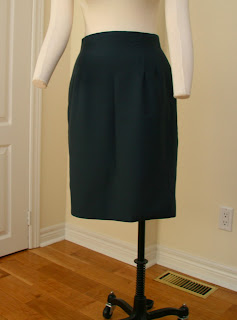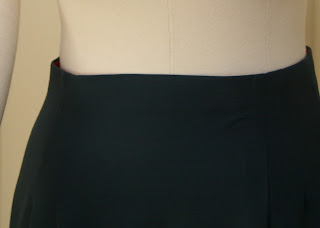Of
course, this means that
I've been on the hook to find a replacement and, believe me, it's all I've thought of,
lo these last 18 hours. Last night, I went through my pattern inventory - Ravelry faves, my own book stash and online library,
free patterns I've bookmarked online and magazines I've
purchase.
Wow
- I've got quite a catalog! I have access to some super modern knits that would serve me well but, really, my heart is set on something vintage. Happily,
I've got a number of those patterns too (the vintage-vintage, the
modernized-vintage, the vintage-inspired) and I believe I've found my
replacement.
 |
| The Fitted Boucle Jacket |
I've been working out the dimensions of the pattern, re-writing it for
my modern eyes (seriously, you can see that the original is 2 paragraphs in length) and considering
how my dimensions are different than those which the pattern calls for.
Proviso:
I'm no fit-your-knits teacher but I like to pretend I play one on TV. BTW, I also pretend I'm a cooking show host when I bake, so I come by this honestly.
Once again, I've decided to spend some time talking about my fitting approach. (Depending, this may take a couple of
posts because I'd like to make it comprehensive and to avoid being a major overwhelmer.)
I Want To Make A Sweater That Fits Perfectly (How Do I Start)?
A) By making sure the vertical and horizontal pattern dimensions match your own: For
starters, I look at the pattern to determine how many stitches
correlate
with each size provided. Then, with the understanding of gauge, with extra feedback from the instructions, I draw a schematic
to show the 3 main shell pieces of the garment (left front, right front
and back) drawing on the vertical and horizontal dimensions of the unmodified size of my choice (aka the presumed best size for me). In this case it's the 34. Yeah, there's gonna be a whole thing about sleeves, but I don't worry about that at this point...
Also, I remeasure myself for accuracy and to determine how the pattern dimensions will need to change to suit me.
In the case of this jacket, I discovered these things:
About the vertical plane dimensions:
- I want the jacket to be longer than the design indicates.
- The armholes are, as usual, way longer than mine so I'll need to shorten them. (Note to self: this is going to fuck with the sleeve cap height?!?!? Do I even have the wherewithal to go through that process again? Will it be any easier? Did I just get lucky the last time?)
- The waist-to-bust area is a little shorter than I require (though not nearly as much as usual) so I'll need to lengthen a smidge.
- I'm going to be adding the bulk of length over the hip because that's where I require the extra length, with this particular design.
About the horizontal plane dimensions:
- The back piece is fine without alteration - except in the hip area where (because I want to make the garment longer than the original design). I will need to add some extra circumference.
- The front piece requires alteration in (no surprise) the bust area (where I could resolve the problem by adding short rows to the tune of 1 inch per side) and in the hip area.
Now,
happily, I've already stockinette swatched the yarn I intend to use
(it's the same yarn I was to use for the now-defunct LDAC). I used a few
needle sizes and, as I knit loosely, on a size US1 needle I get 7.5
stitches per inch. For those of us challenged by this concept - 7.5
inches per inch is bigger gauge than 8 stitches per inch in that it yields a
larger finished product at the same dimensions.
B) By knowing your gauge and/or ensuring that your gauge matches that of the pattern:
Which leads us to the age-old question...
But What If I Can't Get Gauge?
But What If I Can't Get Gauge?
Welcome to the real world, honey. This happens to me all the time!
In addition to all of the dimension alterations I have to take into account (see A, above), the pattern tells me I should be knitting 8 stitches in every inch (horizontal) and 10 rows in every inch (vertical).
Alas, I'm getting - on a needle already one size smaller than the one the pattern recommends - 7.5 stitches per inch (bigger gauge than the pattern calls for) and 12 rows per inch (smaller gauge than the pattern calls for).
Man, that sucks.
Important Note: At this point, if you're not prepared to do a lot more math than you've already done, choose another pattern for which you can obtain gauge. Mind you, that might be tougher than you think... Otherwise, read on. It's really not hard math, just fussy...
Now, in this instance, I'm not sure I'm prepared to make the fabric any smaller by using yet a smaller needle. With this yarn, the stitches are very tiny and have very good definition at a US size 1 providing a nice amount of fabric ease at that tension. The boucle jacket pattern suggests using a size 11 (which, in ye olde terms is equivalent to a US size 2, as far as I can tell). If I go down another needle size perhaps I will achieve gauge horizontally but I'll be even more fucked on the vertical plane. The question is - do I really want to make that needle smaller still?
Man, that sucks.
Important Note: At this point, if you're not prepared to do a lot more math than you've already done, choose another pattern for which you can obtain gauge. Mind you, that might be tougher than you think... Otherwise, read on. It's really not hard math, just fussy...
Now, in this instance, I'm not sure I'm prepared to make the fabric any smaller by using yet a smaller needle. With this yarn, the stitches are very tiny and have very good definition at a US size 1 providing a nice amount of fabric ease at that tension. The boucle jacket pattern suggests using a size 11 (which, in ye olde terms is equivalent to a US size 2, as far as I can tell). If I go down another needle size perhaps I will achieve gauge horizontally but I'll be even more fucked on the vertical plane. The question is - do I really want to make that needle smaller still?
Reasons Why I Might Deliberately Forgo Gauge:
- Well, for starters, a smaller needle will produce an even tighter fabric than the one I've got, having less ease than I might enjoy as this yarn is NOT super wash, it's wool and it's quite firm. (Even as I say this, I should disclose, I have generally found that knitted-garment ease is too giving no matter what I think as I begin a project.)
- Then there's the fact (alluded to above) that, once you go down more than one needle size, you are increasingly unlikely to ever get gauge vertically, even if you can swing it horizontally (which is also increasingly unlikely for reasons defined by physics, as far as I can tell. FYI, when you can't explain something, blame it on physics). Recall, when it comes to altering that sleeve cap - and really many of the alterations in this project as the bulk of those alterations are vertical - it's all gonna be about the vertical gauge.
- Furthermore, and I realize this is petty: it's gonna take that much longer to knit it up on a smaller needle size which, given that I like the stitch definition at 7.5 stitches seems sort of counterproductive.
- Finally, I did some additional math to determine how NOT getting gauge (i.e. being 0.5 of a stitch off) will affect the final dimensions (leaving aside the matter of fabric ease) and I end up achieving almost the exact bust dimension I require at the larger gauge. No short rows required. In this instance I'll merely have to add a couple of stitches at the bust area under the arm, and taper down at the waist. The hip alteration will also be less intensive because I won't have to add in as many additional stitches and then work at decreasing them as I move towards the waist. The waist may be a bit big at this larger gauge, but I sense it will be easier to remove inches there than to increase them everywhere else. Even the shoulder width, while larger than that prescribed in the original pattern, should be ok as it merely increases by an inch over the entire circumference and the original was not huge on the size 34. People in the old days had smaller frames.
Easy For You to Say, But Where Can I Find Actual Detailed Fitting Resources??
- Believe it or not, I've learned most of what I need to know from Stefanie Japel's Craftsy Class: Fit Your Knits. And from a fair amount of online reading and trial and error. Can't give trial and error enough credit peeps.
- Evie makes Amy Herzog's (well-known knit-fitter extraordinaire) Craftsy Class sound de rigeur, though in truth I haven't watched it yet.
(Sure, there are dozens of other resources I could name, but why get overwhelming. I think you could manage all the ins and outs with a Craftsy class or two...)
What's Next For Kristin?
What's Next For Kristin?
- For better or worse, now that I have all the info at my fingertips, I've got to rewrite the actual pattern to account for my dimensions and my version of gauge. This isn't quick but it's not hard and the classes mentioned above will help you to do that with a pattern of your own.
- Then, gotta figure out the sleeve cap situation. No point in getting too far in if I can't sort that one out. Thankfully, so many of you sent fabulous info on this process the last time I had to consider it with the Princess Jumper. I intend to sit down with some graph paper and come up with some answers.
Oh, if you're still reading, do share your feelings about today's questions: Do you like this jacket and would you make it? Do you like it as much as the scrapped LDAC? What would you do? Knit at 7.5 stitch gauge or go for "accurate" gauge and make more/different alterations? Are you a dyed-in-the-wool pattern-adjuster or do you hate the thought of it? If you hate the thought, what might make the idea more appealing? Let's chat!


















